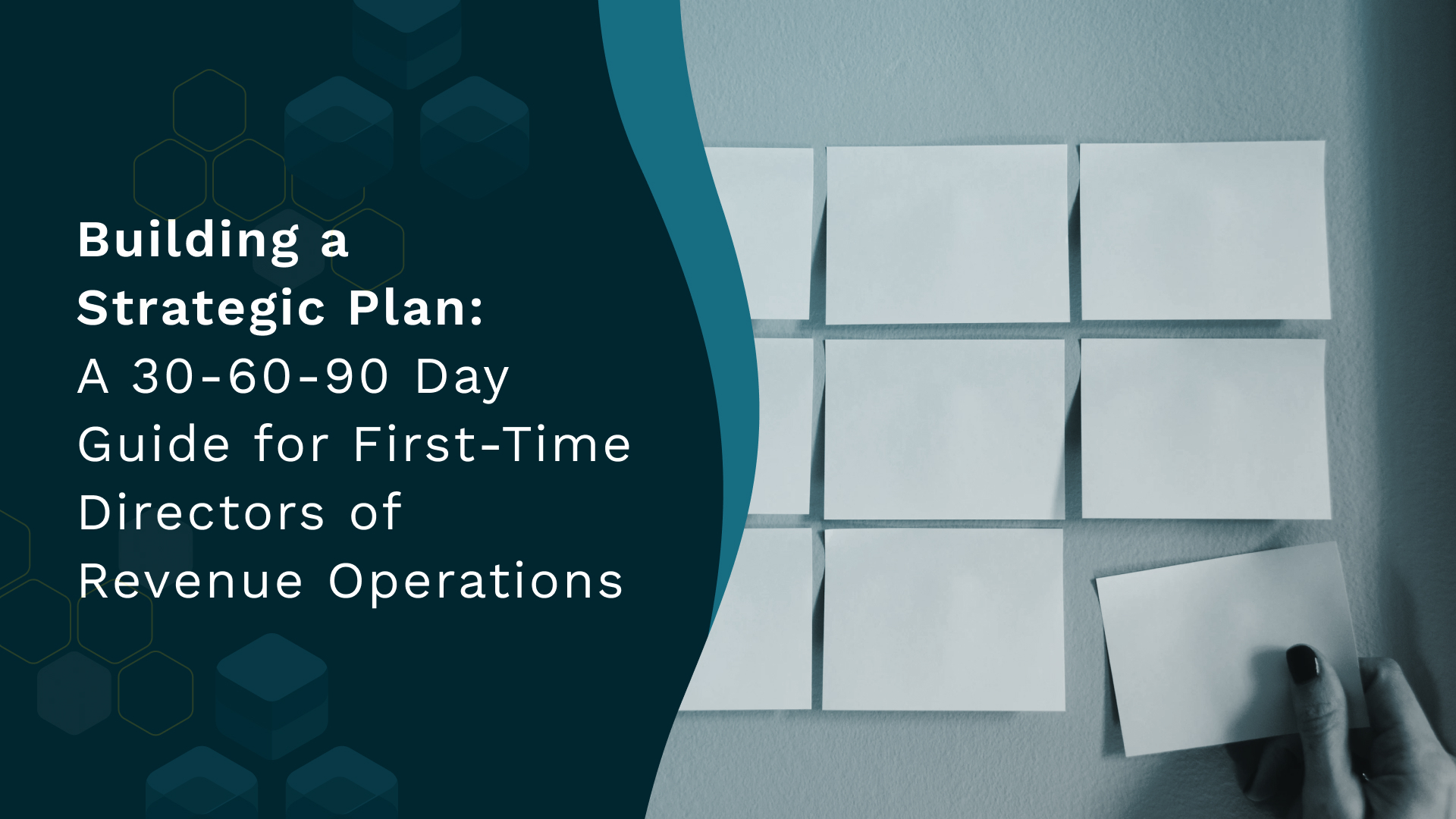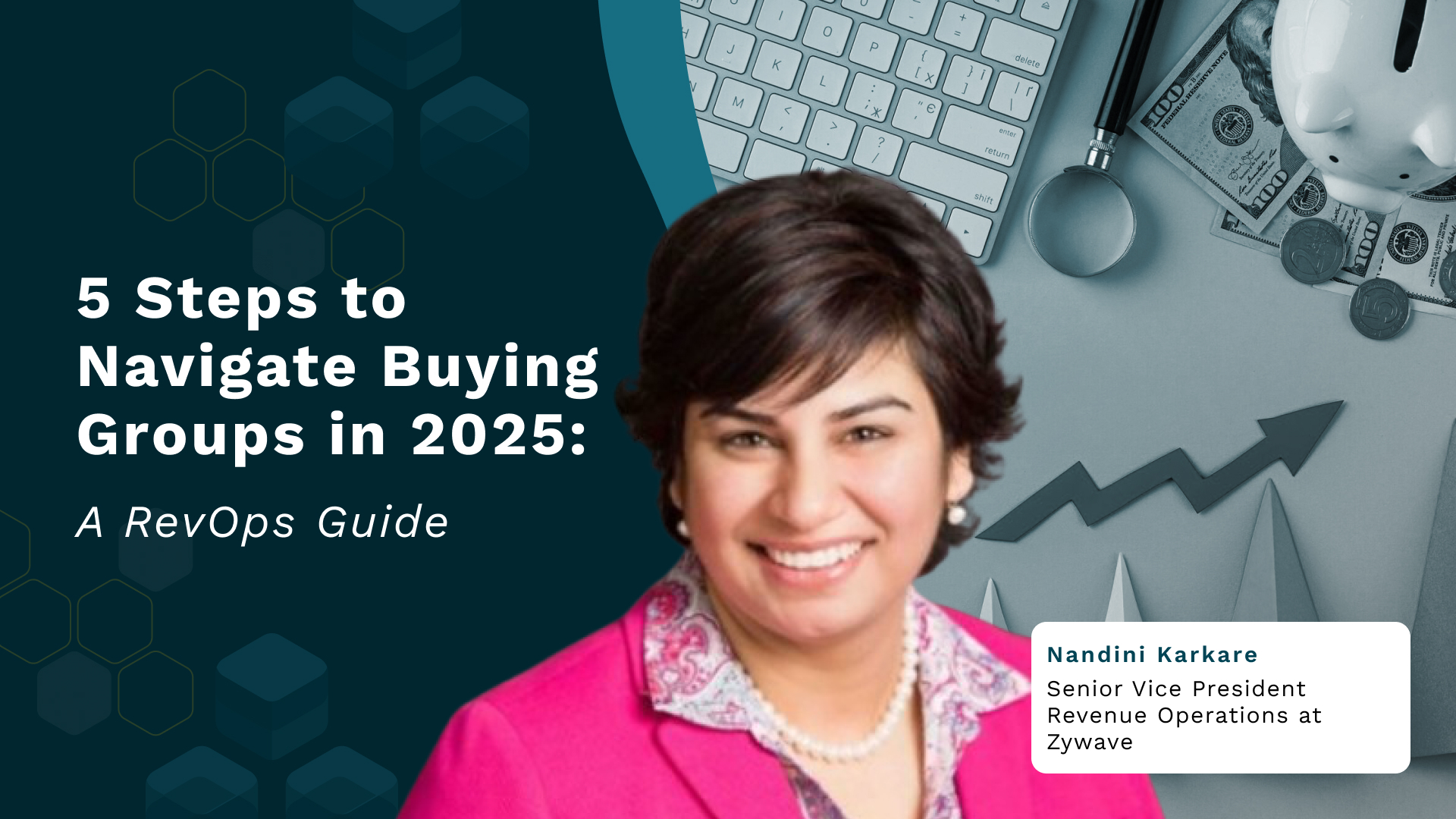Modern ABM and Demand Generation in the Age of Buyer Fatigue
A conversation with Rick Collins, VP of Demand Generation at Connectwise.



“We’ve hit what I call the Great Ignore. Everyone’s overwhelmed with messages across channels… even the good ones are getting ignored.”
In the past 12–18 months, pipeline generation has become increasingly challenging. Rising revenue goals and shrinking budgets have pushed marketing teams into a corner. Traditional tactics—especially high-volume lead generation—are no longer effective. In this environment, Account-Based Marketing (ABM) has emerged as a vital strategy. But to truly succeed, teams must rethink how they define ABM, how they align with sales, and how they scale through integrated processes.
This blog, based on a Revenue Lounge podcast episode with Rick Collins, VP of Demand Generation at ConnectWise, is your deep dive into:
The evolution of ABM in modern demand gen
Aligning go-to-market teams
Building operational systems for scale
Tools, data, and attribution best practices
Key lessons Rick learned the hard way
From IT to Demand Gen: Rick's Unconventional Path
Rick’s journey began in IT—working in QA, implementation, and CRM systems. Over time, he gravitated toward marketing operations, and eventually demand generation.
“I bring a different lens to demand gen. I’ve built the ops side first, which gave me an appreciation of data, systems, and how to scale programs with precision.”
He was the first marketing ops hire at ConnectWise, scaled the team through multiple acquisitions, and later took over demand gen during one of the toughest periods for pipeline creation in SaaS.
The Death of Traditional Lead Generation
Rick calls out three seismic changes that made legacy demand gen ineffective:
The Rise of the Empowered Buyer: Buyers now reach 80–90% of the way through the journey before contacting a vendor.
Digital Fatigue: Automation misuse has saturated inboxes and weakened outreach quality.
Market Competition: More players, more noise, and higher ad costs.
“We used to be a lead-gen machine. Now it’s all about understanding signals, providing value, and making every touchpoint count.”
Strategies That Actually Work
Rick’s team has focused on three core strategies to cut through the clutter:
1. Provide Thought Leadership Without Selling
Publish content that helps the audience do their job better.
Avoid product mentions in early stages.
“The more we can help you without asking for anything, the more trust we build.”
2. Respond Fast When Intent is Declared
If someone shows intent, ensure a quick, seamless follow-up.
Architect systems for real-time handoff to sales.
3. Revive Direct Mail
Physical mail cuts through the noise and makes an impact.
Combine gifting with value-driven messaging.
“You send me a direct mail piece—I’m going to see it. It stands out.”
ABM is Not a Tool. It’s a Strategic Motion
“Start with the strategy. Don’t buy the tool until you know what you want to achieve.”
Too many organizations make the mistake of buying an ABM platform before defining their motion. Rick recommends starting small and proving success manually.
Strategic ABM Checklist:
Define your Ideal Customer Profile (ICP) based on firmographic and technographic criteria
Segment and tier accounts (e.g., Tier 1: High-Value, Tier 2: Strategic Growth, Tier 3: Scalable Outreach)
Involve sales in validating and refining account lists
Build cross-functional account plans with sales and SDRs
Develop persona-specific messaging and value narratives
Align marketing and sales cadences for multi-threaded outreach
Choose channels and tactics based on account tier (field, digital, gifting, events)
Establish shared KPIs and cohort-based measurement plans
Start small (e.g., pilot 25 Tier 1 accounts), iterate based on learnings
Scale with technology only after proving success manually
MQLs vs Buying Groups: A Nuanced Approach
Rick doesn’t claim MQLs are dead—but they are misunderstood. The definition varies drastically across companies. What’s more effective? Tracking buying group signals.
“We’re operating under the buying group model in our upmarket motion. One person may raise their hand, but we’re watching the whole committee.”
Infographic: MQL vs Buying Group Comparison
| Criteria | MQL | Buying Group |
|---|---|---|
| Focus | Individual | Committee/Swarm |
| Common in | SMB | Enterprise, Mid-market |
| Trigger | Email open, form fill | Intent + multiple touchpoints |
| Limitation | Ignores influence | Holistic engagement |
| Ideal motion | Automated lead nurture | High-touch ABM |
Solving Attribution & Measurement Challenges
“We use cohort reporting to measure ABM. Attribution is helpful, but it’s directional.”
Attribution is complex—especially when sales teams don’t tag every contact or touchpoint in CRM. Rick’s solution is cohort-based reporting:
Cohort Reporting Process:
Choose a set of 500 target accounts
Launch a defined campaign or series of campaigns
Measure:
Pipeline creation
Opportunity conversion
Win rates
Double-click into successful accounts and identify what worked
Aligning with Sales: The Non-Negotiable Element
“If sales isn’t bought in, it’s just marketing playing by themselves. It doesn’t work.”
Rick emphasizes that sales buy-in is crucial. Here’s his playbook for driving that alignment:
Sales Alignment Checklist:
Infographic: Joint Sales-Marketing ABM Execution Plan
| Phase | Action | Owner |
| Account Selection | Agree on Tier 1 accounts | Sales + Marketing |
| Persona Mapping | Identify roles & pains | Marketing |
| Messaging | Customize value stories | Marketing + Enablement |
| Outreach | Sequence delivery | SDRs + Reps |
| Follow-Up | Meetings & nurture | Sales |
| Reporting | Track cohort progress | Ops |
Tech Stack and Data Activation: A Pragmatic View
“Tools won’t fix your strategy. They help scale what’s already working.”
Rick breaks the ABM tech landscape into three layers:
Signal Aggregation – intent data, website visits, email behavior.
Activation – digital ads, gifting, outreach.
Measurement – pipeline contribution, cohort lift, influence.
His recommendation: push data into Salesforce and trigger workflows from there. Otherwise, data sits idle.
“We built a prospecting dashboard showing intent scores, untouched accounts, and pipeline priority. Next step: automate the whole motion.”
Balancing Short-Term Metrics vs Long-Term Relationship Building
“If someone has the answer to balancing short- and long-term pipeline generation, I’m all ears.”
Rick’s team avoids meeting-based comp for SDRs. Instead, they’re measured on accepted pipeline and closed-won influence. But this is still a work-in-progress.
SDR Measurement: Old vs New
| Model | Meeting-Based | Pipeline-Influence-Based |
| Pros | Easy to track | Aligned with revenue |
| Cons | Short-term focus | Complex to implement |
| Outcome | Flimsy meetings | Better qualified pipeline |
The Power of Insightful Personalization
A campaign that stood out to Rick? A vendor targeting ConnectWise built a hyper-personalized series referencing his CMO’s Boston roots and even tied it to Tom Brady.
“It wasn’t just clever—it was relevant. And it solved a real pain. That’s what made it stick.”
Lesson: Don’t just personalize. Make it insightful and timely.
Final Lessons Learned
“We made two big mistakes early on: Lack of executive alignment and poor account selection.”
What Rick Would Do Differently:
Spend more time aligning with sales leadership.
Don’t rely only on systems to pick accounts—get sales input early.
“Sales will throw out your list if even one account looks off. And then you’ve lost them.”
Conclusion: Context is Everything
“As a demand gen leader, 60% of my job is setting context. Why does this matter? Why should our CRO care?”
Rick’s approach blends strategy, systems thinking, and human alignment. ABM success isn’t about tech or tactics—it’s about trust, process, and focus.
Want to hear more stories from revenue leaders? Subscribe to The Revenue Lounge podcast to never miss an episode!
More Resources

A 30-60-90 Day Guide for First-Time Directors of Revenue Operations
A 30-60-90 Day Guide for First-Time Directors of Revenue Operations RevOps 10 min Starting a new job as a Director of Revenue Operations is an exciting opportunity to make a significant impact on a company’s revenue growth. To ensure success in this role, it’s essential to have a strategic plan that guides your actions during the crucial first three months. Here’s a 30-60-90 day plan that will help you strategically manage revenue operations and drive sustainable growth. We recently spoke to Hassan Irshad, Director of RevOps at FEVTutor. He shared his approach to this powerful framework, demonstrating how each phase (30, 60, and 90 days) builds strategically upon the last to deliver alignment, trust, and sustained improvement. By breaking down complex goals into achievable milestones, the 30-60-90 day approach empowers RevOps leaders to initiate meaningful change without overwhelming teams. For all the RevOps leaders, it’s a way to approach change with purpose, driving measurable impact and laying the groundwork for long-term success. The 30-60–90 day framework must be an indispensable tool and here is how you can implement progressive, sustainable growth strategies from day one. First 30 days for a Director of Revenue Operations The purpose should be to gather insights and understand the organization, especially the needs and challenges of different teams. 1. Goals for first 30 days: i. Meet Key Stakeholders Meet with cross departmental teams like Finance, HR, and Sales to understand their goals, challenges, and priorities. ii. Document Everything Create a “lay of the land” document summarizing findings on different team goals, challenges, and processes. iii. Understand the Product Take product demos, listen to sales calls, and use tools that show how the product is sold. This helps in understanding the customer needs better. iv. Dive into Your CRM Understand your CRM (whether Salesforce or HubSpot) to assess how the data is organized. This is to check whether it’s easy to use, and identify immediate improvements. The CRM should be the central source of truth, with other tools supporting it. The data should be unified with easier adoption for the teams. v. Build Trust Internally Establish trust within your teams by listening carefully, asking questions about how RevOps can help, and addressing quick fixes to show you’re there to help. Having this trust shows them that you’re here to support their success. Quick wins, such as small fixes that make people’s jobs easier, helps in establishing credibility early. 2. Establish Clear KPIs i. Understanding Team KPIs It is important to ask you stakeholders about the KPIs that matter to understand their goals and what their expectations are. ii. Aligning KPIs Across Teams Different departments oftentimes work in silos. RevOps should strive to align these departments and check if these KPIs match the overall business objectives. Gaps must be closed if their KPIs don’t align. iii. Setting RevOps KPIs As you approach the end of the first 30 days, start establishing RevOps-specific KPIs that match company goals, which may involve metrics like revenue increase, conversion rates, or improvements in overall efficiency. 3. Tech Stack Audit Deep dive into the existing tools that your company is using. Identify all redundancies, and find opportunities to streamline the entire tech stack. i. Map Out Tools Compile a list of all tools used by teams, noting their purpose and how they work with the CRM. ii. Evaluate Use and Cost Determine if tools are actively used or if there are duplicates. Look for cost-saving opportunities by consolidating tools when possible. https://www.youtube.com/watch?v=sVDJ9KI1tGw&t=869s Next 30 days – Alignment and Control The next 30 days marks a shift from discovery to alignment. The goals should be to create cohesion between departments (e.g., Sales, Marketing) and laying down effective controls. The improvements need to be implemented without overwhelming the teams. This phase combines further exploration with actionable improvements with the primary task being bringing the teams into sync. 1. Ways to bring your teams together i. Encouraging cross-team collaboration by addressing silos and ensuring all teams work toward shared quarterly or company-wide goals. ii. By creating alignment, you help teams see RevOps as a support system rather than an enforcer. This keeps communication channels open and creates buy-in. iii. Based on your findings, introduce controls wherever needed to improve workflow. Example: If close dates aren’t being recorded properly, this could skew reports. Meet with sales, identify the root cause (e.g., manual data entry that is taking too much of a reps’ time), and provide solutions or tools to make their tasks easier. Ensure that controls are practical and developed with the trust built in the first 30 days. Foster internal consensus within teams so that these improvements are adopted seamlessly. 2. Navigate Organizational Politics (i) Barrier Removal Larger organizations may have internal politics or ingrained processes that resist change. Find an internal “sponsor” who trusts and supports RevOps initiatives and can authorize actions to navigate any resistance. (ii) Trust and Consistency As you implement changes, make sure your efforts consistently demonstrate how RevOps can make work easier and more efficient for everyone. 3. Evolving the Tech Stack (i) Assessing Tech Needs If tools aren’t fully integrated (e.g., a tool not writing data back to the CRM), identify their gaps and consider evolving the tech stack. (ii) Holistic View Use insights from the discovery and alignment phases to start envisioning necessary tech improvements that align with company goals. Beginning of the 90-Day Phase: Vision and Execution This phase, described as “Vision and Execution,” involves shaping and executing a strategy based on insights gathered from the discovery and alignment phases. a. Roadmap Creation Create a roadmap covering the next two quarters, focusing on long-term, high-impact changes that align with business goals. Use learnings based on stakeholder needs, organizational goals, and the findings from the first 60 days i. Set Priorities Collaborate with end users (Sales, Marketing, Customer Success) to understand their pressing needs and align the roadmap with these needs. ii. Strategic Execution Prioritize initiatives that will have immediate revenue impact or

Top 10 Relationship Intelligence Tools for 2025
Top 10 Relationship Intelligence Tools for 2025 RevOps 10 min When it comes to sales, building strong relationships is essential. But let’s face it, the process can be incredibly time-consuming and demands a significant amount of effort from the sales reps. But here’s the kicker: Today, 44% of millennial buyers prefer minimal contact with a sales rep during the buying process. That means your sales rep has ~5% of the prospect’s time to establish a connection. It’s tougher than ever to develop relationships from a seller’s point of view. Does this mean that your reps should stop building relationships? Should your reps just try and sell whatever they can to whoever you find? The answer to that is a resounding NO. In the digital era, data and insights are what drive sales . They have the potential to give out more information than you know about your prospects. CRMs capture all possible data, churning it and spurting out information that otherwise was not visible earlier. But wait. There’s more to sales success than your CRM. To truly understand your prospects, you need to dig deeper to uncover hidden insights to help close your deals faster. That means mining your CRM data for a wealth of valuable information that will give you a competitive edge. This is exactly what relationship intelligence does. What is a Relationship Intelligence Tool? Picture this: You have access to a wealth of data from your clients, colleagues, and partners, but it’s scattered across various touchpoints like emails, phone calls, messages, meetings, and more. How do you make sense of all that information? That’s where relationship intelligence comes in. By pooling in, processing, and analyzing all that data, relationship intelligence technology provides invaluable insights, builds stronger relationships, and helps you make smarter decisions. With relationship intelligence, you can discover a treasure of data-driven and actionable insights that support the organization’s understanding of the customer, identify the optimal solutions, and determine the best communication strategies. This results in a more tailored and informed approach to prospects to maximize the best chance of a positive outcome. Your prospects are more than just a phone number or an email. Relationship intelligence broadens your potential and plays a strong role in connecting the dots from other sources. It supplements your CRM, finding other & useful opportunities to close prospects, otherwise not visible to us. Why Does a Relationship Intelligence Tool Matter? Enterprise-based selling in B2B is no walk in the park. With a plethora of relationship intelligence tools out in the market, organizations are spoilt for choice. However, tools that leverage AI/ML, offering data-driven intelligence with invaluable and actionable insights, will be the ones that will dominate the market. On the flip side, the process of onboarding a tool no longer rests in the hands of a single decision-maker. Gartner states that the number of buyers involved in the last decade has increased from 5 to 20. A potential account will have multiple stakeholders who will be involved in the decision-making process. Hence, it becomes critical for sales reps to identify and engage with key stakeholders regularly. With the rise of digital selling, organizations can now track the process of selling in a more in-depth manner. All forms of digital outreaches and communication with prospects can now be tracked, analyzed, and acted upon with the help of relationship intelligence. Today, with markets being down and companies being extremely meticulous in their choice of tools to invest, having a relationship intelligence tech stack will be the game-changer. Here’s how 1. Showcasing a single view of all your relationships with your prospects Having relationship intelligence data will bring together all the stakeholders in one view, so sales reps have a clear idea of the sales cycle the account is currently in. 2. Identify every stakeholder involved With the buying process evolving constantly, the final decision often lies not with one but multiple owners. In other words, for a sales rep, multithreading is the best way forward. And in this process, it’s very easy to confuse the right person to engage with, especially if there is a handover involved. Sales reps often fail to map out the stakeholders involved. The dots are not connected and not visible, which can lead to confusion and no clarity to other higher authorities. Relationship intelligence tools fill these gaps. It will identify each & every stakeholder involved at every stage of the selling process, bring them together, and map out the relationship of each, and provide all the information about these stakeholders. Not only that, but the data also provide insights to those who are frequently engaging and also point out the next best champion to continue the sales process seamlessly if the key decision maker is unavailable at any stage of the sales process. 3. Give detailed insights about each prospect The thing about relationship intelligence tools is that not only do they provide details in one place, but they also show you the best possible way to contact and reach out to your prospects. It can be email, phone calls, or video calls; it will give you solutions that are sure to boost your process of converting. 4. Recover lost leads In the world of sales, not all leads or prospects will convert. If the target is to convert 2 leads in a month with a value of X, sales reps need to build a pipeline of at least 10 leads with a value of 10X. This results in 8 leads that will not convert or be disqualified or lost in the process. However, these 8 leads don’t have to be lost forever. With relationship intelligence, you can identify the most engaged buyers and reignite the relationship with them. And here’s the kicker: the relationship intelligence technology considers all the data even before onboarding the tool. This kind of intelligence will only unleash hidden superpowers for your sales reps. Who knows, your lost prospect’s business priorities might have changed over time, and getting back to them might just make all the difference. 4. Discover trends in

5 Steps to Navigate Buying Groups in 2025: A RevOps Guide
5 Steps to Navigate Buying Groups in 2025: A RevOps Guide RevOps 10 min In today’s business environment, B2B buying is never just one person. According to Forrester Research, more than half of global business buyers purchase in complex buying scenarios that include more people, more departments, and generally higher price points. And this buying group can be made up of 7 to 20 people! Unlocking the power of buying groups is a crucial aspect of the B2B landscape. This blog is a synopsis of our conversation with revenue operations leader, Nandini Karkare. She is currently the SVP of RevOps at Zywave. Nandini suggests strategic steps to navigate through the realms of Revenue Operations and helps uncover the strategies, insights, and best practices that constitute a comprehensive guide to mastering the dynamics of buying groups. Read on to get actionable tips on how you can navigate buying groups in 2025 (and beyond). And implement the learnings to create a winning GTM motion. Here are the 5 steps Nandini recommends: 1. Decode Your Buying Groups The buying groups typically consist of members from departments and they all contribute different aspects. It is critical to understand the scope of decision-making including the people who play the most significant roles in making the call. Gartner’s report on B2B Buying highlights that 77% of B2B purchases involve a buying group of four or more people. PS: The key stakeholder can turn out someone altogether different from who you had building a relationship with all along. a. Capturing Buying Group Members Effective buying group management means considering not just decision-makers but influential stakeholders across departments. Misidentifying key players or focusing solely on the main contact risks derailing the sale. (i) How can you map the entire buying group efficiently? Leverage internal and external data to identify the key players Segment the Group by Role and Influence (ii) Not everyone in the buying group holds equal power or influence. Segment them into categories: Decision-makers (who give the final heads-up) Influencers (who sway the decision) Users (who use the product and provide feedback) Budget owners b. The Role Transition Within a Buying Group Moving the focus from a buying group to a renewal or expansion committee includes knowing precisely who remains in the relationship, as well as who becomes more active as an account grows. (i) New roles may emerge in a Buying Group Technical or operational leaders may become more influential post sale, since they are now using the product. (ii) The focus shifts from buying to renewal The interaction should be more about the return on investment (ROI) of the product placed on the market, ongoing value delivery, and ongoing needs. (iii) Alignment between the buying groups and renewal committee Leveraging the same enthusiasm and relationships generated at the first-buying stage helps in anchoring the transitions and preventing any drop-offs in engagement. Related Resource: Navigate Enterprise Buying Committees: Strategies for Driving Alignment c. Understand the Personal and Collective Priorities of a Buying Group As per McKinsey & Company, B2B buying decisions increasingly require engagement across departments, with 60% of purchasing committees including members from outside traditional procurement, like IT and HR. (i)Alignment Between C-Suite and Technical Teams Decisions aren’t Made in a Vacuum Collaboration between C-suite and technical teams ensures a holistic approach to solving customer problems, creating stronger, more sustainable relationships Their cross departmental collaboration can help with: (ii) Alignment on Strategic Goals C suite executives need technical assistance to translate their strategic vision to reality that also aligns with company-wide objectives. (iii) Technical Validation These insights guide the C-suite in making informed decisions that fit technical infrastructure and future-proofing. (iv) Cross-functional Communication Bridging the gap between these two groups involves continuous, open communication, ensuring that technical evaluations don’t delay business goals but instead support them cohesively. iii. Understand the Product Take product demos, listen to sales calls, and use tools that show how the product is sold. This helps in understanding the customer needs better. iv. Dive into Your CRM Understand your CRM (whether Salesforce or HubSpot) to assess how the data is organized. This is to check whether it’s easy to use, and identify immediate improvements. The CRM should be the central source of truth, with other tools supporting it. The data should be unified with easier adoption for the teams. v. Build Trust Internally Establish trust within your teams by listening carefully, asking questions about how RevOps can help, and addressing quick fixes to show you’re there to help. Having this trust shows them that you’re here to support their success. Quick wins, such as small fixes that make people’s jobs easier, helps in establishing credibility early. 2. Establish Clear KPIs i. Understanding Team KPIs It is important to ask you stakeholders about the KPIs that matter to understand their goals and what their expectations are. ii. Aligning KPIs Across Teams Different departments oftentimes work in silos. RevOps should strive to align these departments and check if these KPIs match the overall business objectives. Gaps must be closed if their KPIs don’t align. iii. Setting RevOps KPIs As you approach the end of the first 30 days, start establishing RevOps-specific KPIs that match company goals, which may involve metrics like revenue increase, conversion rates, or improvements in overall efficiency. 3. Tech Stack Audit Deep dive into the existing tools that your company is using. Identify all redundancies, and find opportunities to streamline the entire tech stack. i. Map Out Tools Compile a list of all tools used by teams, noting their purpose and how they work with the CRM. ii. Evaluate Use and Cost Determine if tools are actively used or if there are duplicates. Look for cost-saving opportunities by consolidating tools when possible. https://www.youtube.com/watch?v=sVDJ9KI1tGw&t=869s Next 30 days – Alignment and Control The next 30 days marks a shift from discovery to alignment. The goals should be to create cohesion between departments (e.g., Sales, Marketing) and laying down effective controls. The improvements need to be implemented without overwhelming the teams. This phase combines